英语人教版九年级全册主动语态与被动语态
- 格式:doc
- 大小:23.50 KB
- 文档页数:6
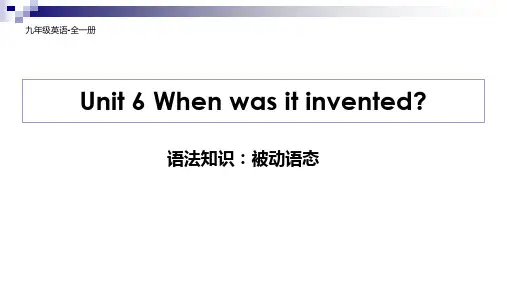
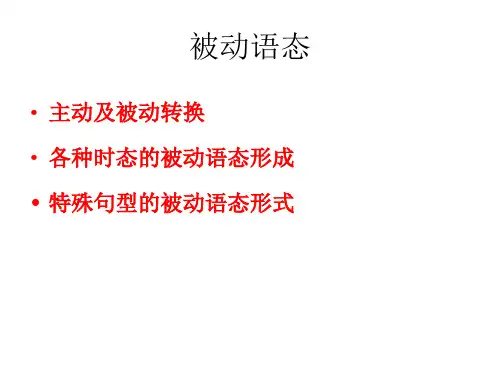

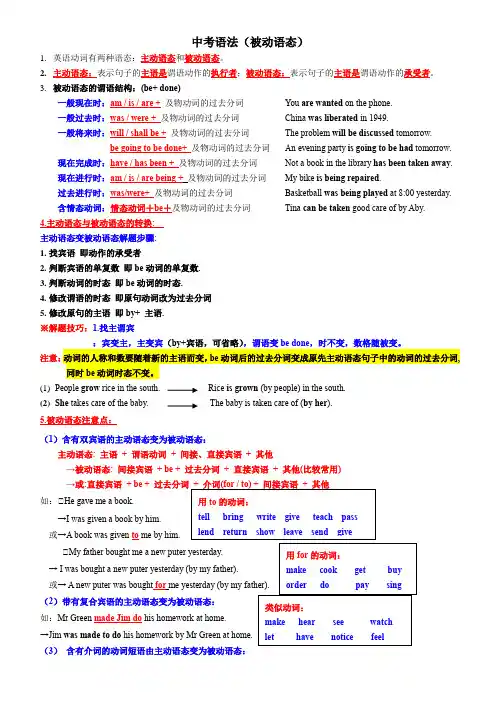
中考语法(被动语态)1. 英语动词有两种语态:主动语态和被动语态。
2. 主动语态:表示句子的主语是谓语动作的执行者;被动语态:表示句子的主语是谓语动作的承受者。
3. 被动语态的谓语结构:(be+ done)一般现在时:am / is / are + 及物动词的过去分词 You are wanted on the phone. 一般过去时:was / were + 及物动词的过去分词 China was liberated in 1949. 一般将来时:will / shall be + 及物动词的过去分词The problem will be discussed tomorrow. be going to be done+ 及物动词的过去分词An evening party is going to be had tomorrow. 现在完成时:have / has been + 及物动词的过去分词 Not a book in the library has been taken away . 现在进行时:am / is / are being + 及物动词的过去分词 My bike is being repaired .过去进行时:was/were+ 及物动词的过去分词Basketball was being played at 8:00 yesterday. 含情态动词:情态动词+be +及物动词的过去分词Tina can be taken good care of by Aby.4.主动语态与被动语态的转换: 主动语态变被动语态解题步骤: 1. 找宾语 即动作的承受者2. 判断宾语的单复数 即be 动词的单复数.3. 判断动词的时态 即be 动词的时态.4. 修改谓语的时态 即原句动词改为过去分词5. 修改原句的主语 即by+ 主语. ※解题技巧:1.找主谓宾:宾变主,主变宾(by+宾语,可省略),谓语变be done ,时不变,数格随被变。
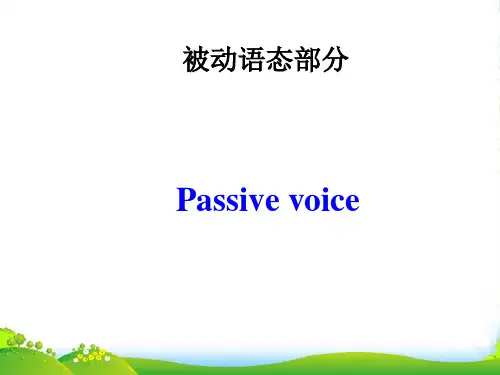
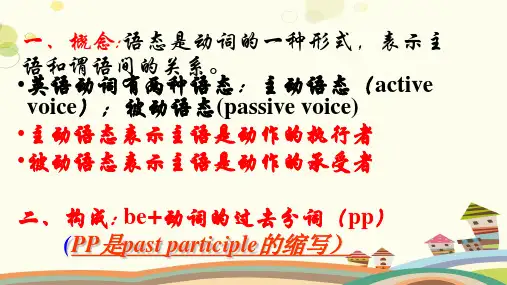
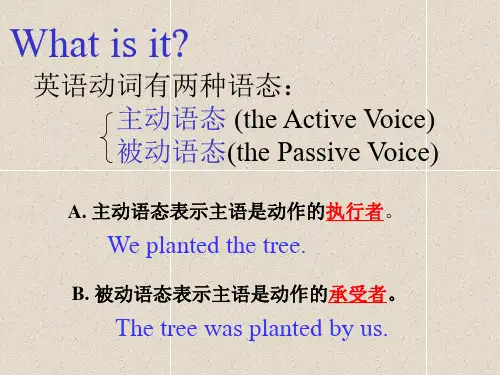
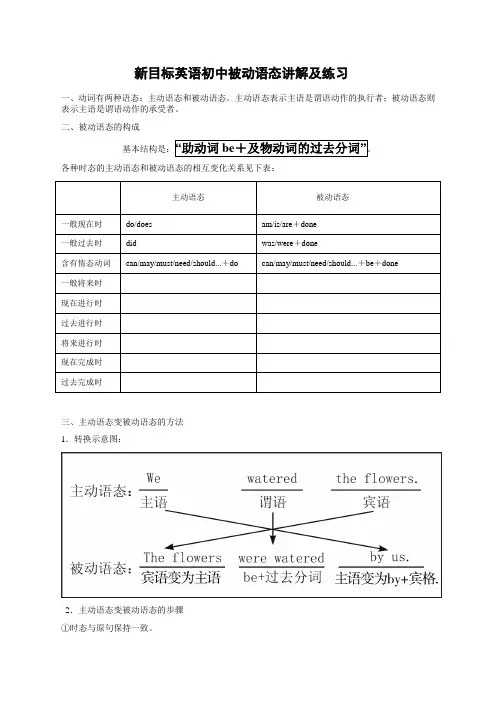
新目标英语初中被动语态讲解及练习一、动词有两种语态:主动语态和被动语态。
主动语态表示主语是谓语动作的执行者;被动语态则表示主语是谓语动作的承受者。
二、被动语态的构成基本结构是:“助动词be+及物动词的过去分词”。
各种时态的主动语态和被动语态的相互变化关系见下表:主动语态被动语态一般现在时do/does am/is/are+done一般过去时did was/were+done含有情态动词can/may/must/need/should...+do can/may/must/need/should...+be+done一般将来时现在进行时过去进行时将来进行时现在完成时过去完成时三、主动语态变被动语态的方法1.转换示意图:2.主动语态变被动语态的步骤①时态与原句保持一致。
②把主动语态的宾语变为被动语态的主语(如果是人称代词,要将宾格变为主格)。
③把谓语变成被动结构“be+过去分词”结构(要注意原句的时态和主语的单复数)。
④把主动语态中的主语改为by构成的介词短语,放在谓语动词之后(by短语有时可省略)。
如:We clean the classroom every day. 我们天天打扫教室。
→The classroom is cleaned (by us) every day. 教室天天(被我们)打扫。
We must send the girl to the hospital at once. 我们必须马上把这女孩送到医院。
→The girl must be sent to the hospital at once (by us). 这女孩必须马上(被我们)送到医院。
四、被动语态的用法1.不知道谁是动作的执行者时。
如:Some new computers were stolen last night. 一些新电脑在昨晚被盗了。
(不知道是谁偷的) 2.没有必要指出谁是动作的执行者时。
如:Books mustn’t be taken out of the library.书不准被带出图书馆。
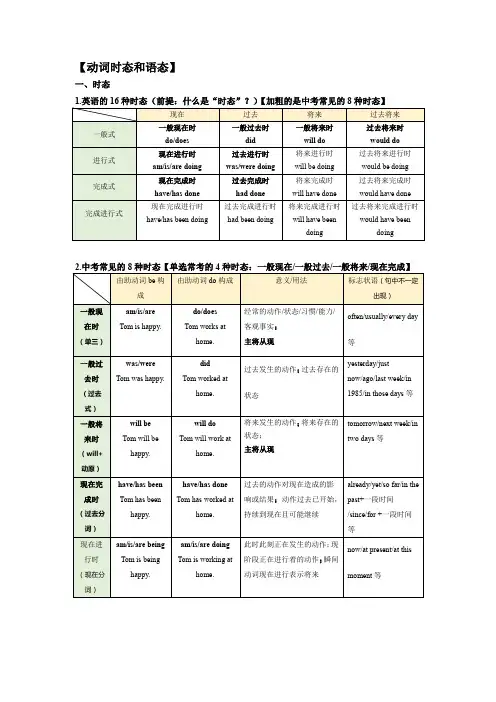
【动词时态和语态】一、时态3.主将从现(1)条件状语从句由if(如果)、as long as(只要)、unless(除非)引导,主句为一般将来时或表述将来含义,从句用一般现在时。
例如:She had better travel with a local tour guide if she wants to know more about the culture.(2)时间状语从句由when(当……时候)、as soon as(一……就……)、until(直到)等引导,主句为一般将来时或表述将来含义,从句用一般现在时。
例如:I’ll discuss this matter with you when we meet next time. / We won’t leave until Mary arrives.考点5 现在完成时have/has+(not+)过去分词(1)表示过去的动作对现在产生的结果和影响现在完成时表示过去某个时间曾经做过的、发生过的事情,对目前的某种影响,这时一般不用时间状语;也可以表示到目前为止没有发生或经历的事情。
The tickets have sold out.(票已售空。
)I have tried Italian food. It’s delicious!(我已经尝过意大利美食了。
美味啊!)Simon has seen the concert. He doesn’t want to see it again.(西蒙已经看过这场演唱会,不想再看了。
)I have never visited San Francisco in the U.S.A.(我从没去过美国的旧金山。
)(说明过去没有去过,现在仍没去过)I have just heard the news that our school will set up a press club.(我刚听到消息说我们学校要成立一个记者俱乐部。
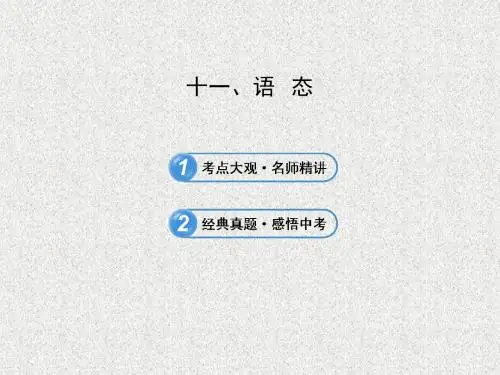

精品基础教育教学资料,仅供参考,需要可下载使用!Unit 5 What are the shirts made of?第1课时Section A(1a2d)fork n. 餐叉;叉子。
一副刀叉为“a knife and fork”,当其作主语时,谓语动词用单数silver n. 银;银器adj. 银色的glass n. 玻璃。
不可数名词,表示“一块玻璃”用a piece of glass environmentaladj. 自然环境的;有关环境的leaf n. 叶;叶子。
其复数形式为leavesproduce v. 生产;制造;出产widely adv. 广泛地;普遍地process v. 加工;处理n. 过程【拓展】(1)glass n.(pl. glasses) 玻璃杯。
glasses n.眼镜。
(2)以f(e)结尾的名词变复数口诀:灰太狼(wolf)为活命(life)去捉羊,贼(thief)人携刀(knife)叶(leaf)丛藏。
架(shelf)后半(half)天不见羊,自己(self)老婆(wife)饿得慌。
be made of/from由……制成be made in由……制造be famous for因……而著名【拓展】用法辨析①be made of…由……制成(看得出原材料)。
②be made from…由……制成(看不出原材料)。
③be made in…由……制造(接地名)。
④be made by…由……制成,后跟动作的执行者。
【图解助记】(2)be famous/known for, be famous/known as和be famous/known to用法辨析①be famous/known for 因为……而著名。
后接出名的原因。
②be famous/known as 作为……而著名。
后接表示身份或地位等的名词。
③be famous/known t o 对……而言是著名的。
英语人教版九年级全册被动语态九年级下册二轮语法专项复习被动语态教学设计英语动词有两种语态,即主动语态(The Active Voice)和被动语态(The Passive Voice)。
主动语态表示主语是动作的执行者,被动语态表示主语是动作的承受者,例如:Many people speak English . (主动语态)English is spoken by many people. (被动语态)知识梳理:提纲挈领,抓住重点和难点!一.被动语态的时态:1.一般现在时的被动语态: am /is/ are +动词的过去分词2.一般过去时的被动语态: was /were +动词的过去分词3.一般将来时的被动语态: will be +动词的过去分词4.现在进行时的被动语态:am /is /are +being +动词的过去分词5.现在完成时的被动语态: have /has +been +动词的过去分词6.情态动词的被动语态:情态动词 + be +动词的过去分词二.主动语态变被动语态的变法:口诀:宾变主,主变宾,谓变be done ,时不变,数格必须随被变。
注:1.主动、被动的时态要一致。
2.主动、被动的句式要一致。
3.变成的被动语态的主语与谓语在单复数上保持一致。
三.特殊情况的被动语态:1.带双宾语的被动语态:动词+ sb(间宾) +sth(直宾)口诀:如遇双宾语,一般变间宾,若把直宾变,to /for 间宾连。
1).give/pass /show 与介词to 搭配。
give sb sth —— sb +be given sth 或 sth +be given +to sb .2).buy/make/cook 与介词for 搭配。
buy sb sth —— sb +be bought + sth 或 sth +be bought +for sbHe gave me a bookI ______ ______ a book by him. A book ____ ____ _____ me by him .My mother made me a cake .I ____ _____ a cake by my mother A cake ____ ____ ____ me by my mother .可有两种被动语态的常用动词有:buy,give,leave,lend,offer,pay,teach,tell,show,等。
英语中主动语态如何变被动语态英语中含有双宾语的主动句变被动语态时,可分别将其中的一个宾语变为主语,另一个不动,但变间接宾语为主语的情况较多。
主动:Tom gave me a present on my birthday. 我生日那天汤姆送我一件礼物。
被动:I was given a present by Tom on my birthday.A present was given to me yesterday.注意:如果把直接宾语(指物)改为主语,则在间接宾语(指人)前加适当的介词。
1. 在下列动词后,通常在间接宾语前用介词to:bring, give, hand, lend, offer, pass, sell, show, take,通tell等。
2. 在下列动词后,一般在间接宾语前用介词for:build, buy, cook, cut, choose, do, fetch, find, fix, get, keep, make, order, paint, play, sing等。
主动:Mother made me a new skirt. 母亲给我做了件衬衣。
被动:A new skirt was made for me.3. 由于某些动词与介词有习惯搭配,既不用to也不用for, 而用别的介词。
如:People all over the world know the Great Wall. 世界上的人都知道长城。
The Great Wall is known to people all over the world. (不用by短语)4. 有时用间接宾语作主语讲不通或不习惯,必须用直接宾语作主语。
如:Tom wrote me a letter.误:I was written a letter by Tom.正:A letter was written to me by Tom.类似的动词还有:return, send, pass, hand, sell, teach等。
主动语态与被动语态
一.概念:主动语态表示主语是动作的执行者,被动语态表示主语是动作的承受者。
●二.被动语态的构成:助动词be+及物动词的过去分词
●三.被动语态的时态:以为work 例:
●1. 一般现在时: am / is/are+ worked
●2. 一般过去时: was / were+ worked●3. 一般将来时: shall / will +be+ worked
●4. 过去将来时: should / would+ worked
●5. 现在进行时: am /is/are+ being+ worked
●6. 过去进行时: was /were+ being+ worked
7. 过去进行时: was/were +being +worked
8. 现在完成时: have/has+ been+ worked
9. 过去完成时: had +been+ worked
10. 将来完成时: shall/ will +have been +worked
11. 过去将来完成时: should/would +have been+ worked
12. 情态动词(can/may/must/should etc.)+be+动词的过去分词
●四. 用法:
●当我们不知道谁是动作的执行者或者没有必要指出
谁是动作的执行者时或者只需强调动作的承受者时,要用被动语态。
五. 方法:
●Many people speak English.(主动语态)
●English is spoken by many people.(被动语态)六. 注意以下问题:
● A. 带有双宾语的动词变为被动语态时,可以把其中一个宾语变为被动语态的主语,若将直接宾语(sth.)变为主语,须根据习惯在原间接宾语前加上介词to或for
用to的常见词有:give, show, send, lend, pass, pay, teach, throw, take, bring etc.
用for的常见词有:make, choose, sing, play, draw, save, buy, get, leave, cook etc.
●eg.
●1. Mary gave him some books.
●He was given some books by Mary.
●Some books were given to him by Mary.
●2. Her father bought her a new bike.
●She was bought a new bike by her father.
● A new bike was bought for her by her father.
●B.带复合宾语(宾语+宾语补足语)的动词变为被动语态时,只能将宾语变为被动语态的主语,宾语补足语不可变为主语。
●eg. 1. We call him Gina.
●He is called Gina (by us).
● 2. They made me happy.
●I was made happy( by them).
● 3. He asked me to come here.
●I was asked to come here (by him)●C. 在see, let, make, hear, watch etc.动词之后,作宾语补足语的动词不定式不带to,但在变为被动语态时,则一定要加上to。
●eg.
●1. We saw them play football just now.
●They were seen to play football just now.
2. We often hear her sing in English.
●She is often heard to sing in English.
●D. 在某些“不及物动词+介词/副词”(相当于及物物动词)的句子中,变被动语态时,注意不要丢掉介词/副词。
eg.
●1. People often talk about that film.
●That film is often talked about.
●2. We should speak to the old people politely.
●The old people should be spoken to politely.
E. 主动形式表示被动意义的词:
●1)某些感官动词:
●look, smell, taste , feel, wear ,sound, etc.
●2)某些及物动词+副词:
● wash, write, sell, read, open, cut, shut, keep,
●etc.
● 1. This coat feels soft.
● 2. The pen writes smoothly.
● 3. That book sells well.
● 4. This kind of shirt washes easily.
●F. 只有及物动词(vt.)才有被动语态,不及物动词(vi.)没有被动语态,因为它不带宾语。
●eg. happen
●What was happened? ×
●What has happened? √●What is happening? √●G. 若主动句的主语是表示地点的名词,变为被动语态时,应将其变为in+名词,作地点状语,而不变为by的宾语。
●eg. Our village opened a new school last year.
● A new school was opened in our village last year.
●H. 若主动句的谓语动词是know变为被动语态时,应将其变为be known to,而不能变为be known by。
● eg. People all over the world know the Great Wall.
●The Great Wall is known to people all over the world.
●I. 若主动句的主语是nobody, no one等否定不定代词时,变为被动语态应将其anybody, anyone作介词by的宾语,并将其谓语动词改为否定的被动语态。
● eg. Nobody can answer this question.
●This question can not be answered by anybody.
一.句型转换 1. A large number of people speak French in Paris.
●French ____ ______ ____a large number of people in Paris.
2. My cousin repaired the broken watch.
●The broken watch ____ _____ _____my cousin.
●3. We should plant the trees around the lake.
●The trees _____ _____ ______around the lake.
●4. My aunt gave me a present on my birthday.
●I ____ _____a present by my aunt on my
birthday.
A present _____ ____ _____me by my aunt on my birthday.。